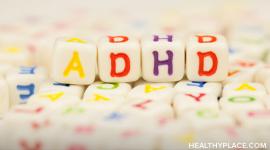Types of ADHD: Inattentive Type, Hyperactive Type, Combined Type

Four types of ADHD are officially recognized in the new Diagnostic and Statistical Manual, 5th Edition (DSM-V), rather than just three types in the previous DSM-IV. The new type is called Inattentive Presentation:
- Inattentive ADHD
- Hyperactive-Impulsive ADHD
- Combined ADHD Type
- Inattentive Presentation (Restrictive)
As one of the most commonly occurring childhood disorders (see What is ADD and ADHD), some people exhibit obvious symptoms of ADHD, while others do not. Physicians and mental health professionals break ADHD into these four groups based on reported patient symptoms and other key criteria.
According to Dr. Laura Markley, a pediatric psychiatrist at Akron Children's Hospital in Ohio, symptoms must appear prior to age 7 for doctors to diagnose a child with any type of ADHD. She adds that boys are far more likely than girls to receive a diagnosis of ADHD.
Characteristics of the Types of ADHD
Inattentive ADHD
Children with the inattentive type of ADHD can sit quietly and do not exhibit overt signs of physical hyperactivity, causing parents or teachers to overlook the possibility of ADHD as a cause of poor academic performance and inability to follow instructions. These children are easily distracted, have poor organization skills, and avoid participating in activities requiring prolonged mental engagement. They may daydream, seem mentally absent, and frequently make careless mistakes when participating in activities or attempting schoolwork.
Hyperactivity/Impulsivity ADHD
Characterized by consistent hyperactivity and impulsive behavior, this form of ADHD is more readily identifiable by those who interact with the child outside of a health care setting, such as parents and teachers. These children disrupt the classroom setting with constant fidgeting and moving around. They frequently interrupt and speak out of turn and have difficulty accepting delayed gratification. The conspicuous hyperactivity/impulsivity associated with this type of ADHD creates urgency in parents, teachers, and others to find a solution; thus, these children may receive treatment earlier.
Combined ADHD
Children with ADHD combined type do not exhibit a distinct tendency toward either category; instead, they consistently display behaviors associated with both. Unlike those whose behaviors lean heavily toward hyperactivity ADHD, these children may have phases where they do sit quietly and can refrain from interrupting others and talking excessively. Still, they are not processing information like a normal child and the more subtle symptoms of inattentive ADHD are continuing to keep them from reaching their full potentials.
Inattentive Presentation (Restrictive)
To qualify for this diagnosis, a patient must meet the criteria for Predominantly Inattentive but have two or fewer of the 12 symptoms from the list for hyperactivity-impulsivity and the symptoms must have been present for at least six months in children.
Considerations
Most children have bouts of hyperactivity, impulsiveness, and short attention spans, especially in the early childhood years. When the behavior is consistent, occurs in more than one setting, such as both at home and school, the child may need an evaluation by a physician or mental health professional who is experienced in diagnosing ADHD.
APA Reference
Gluck, S.
(2021, December 20). Types of ADHD: Inattentive Type, Hyperactive Type, Combined Type, HealthyPlace. Retrieved
on 2025, April 14 from https://www.healthyplace.com/adhd/adhd-children/types-of-adhd-inattentive-type-hyperactive-type-combined-type



